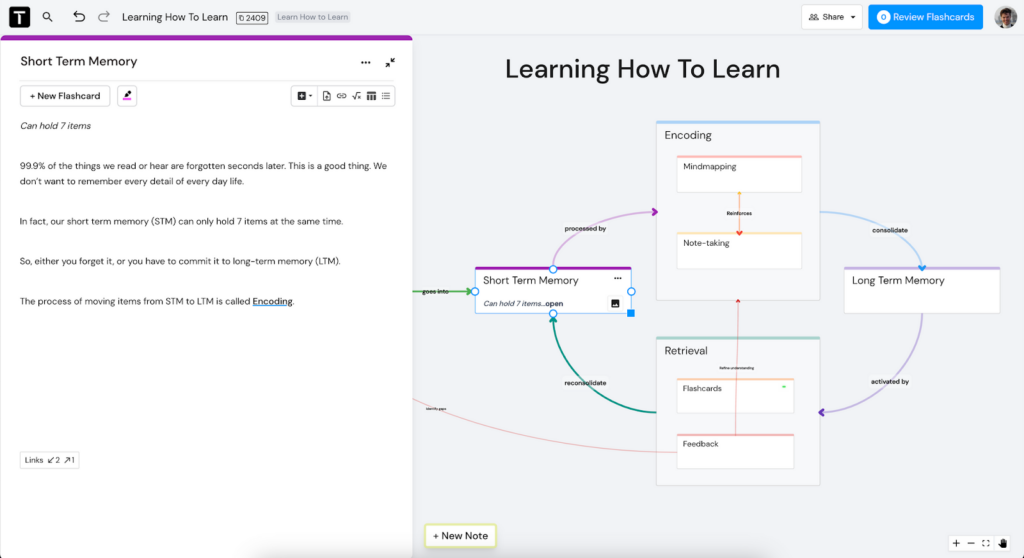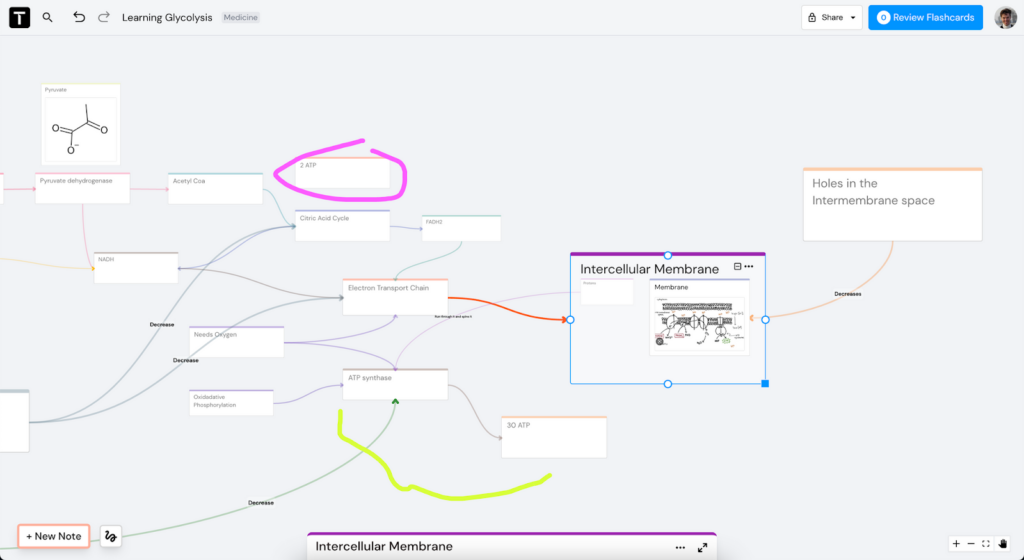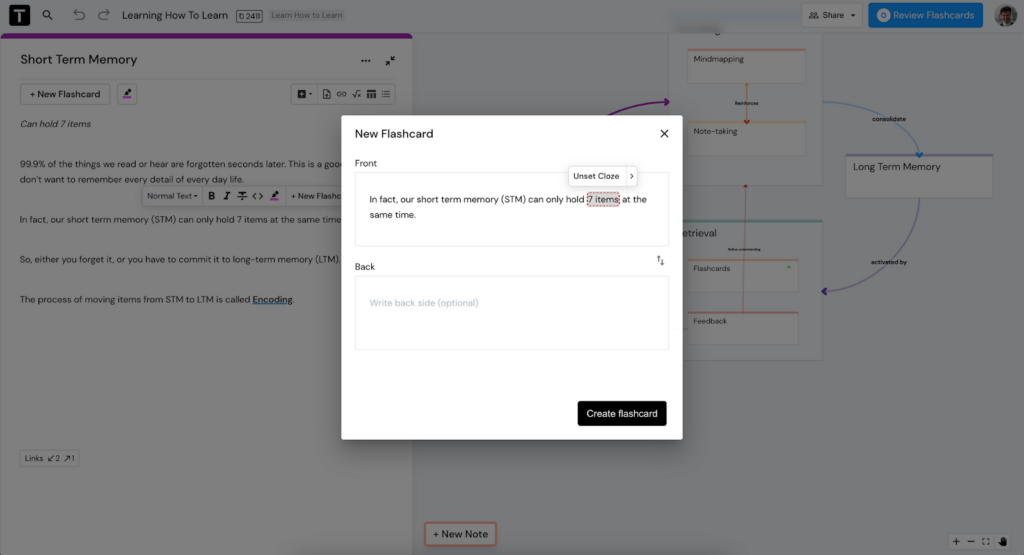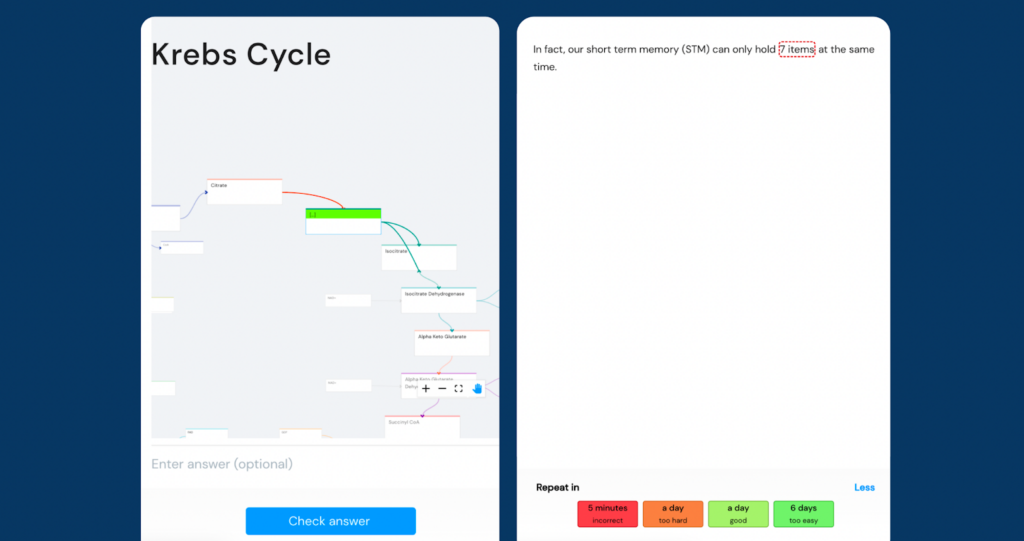Welcome to this edition of our Tools for Thought series, where we interview founders on a mission to help us think better and work smarter. Dom Zijlstra is the founder of Traverse, the only tool with mind mapping, note-taking and spaced repetition flashcards in one place. Traverse uses science-based features to help you deeply grasp complex topics so you can remember them for life.
In this interview, we discussed how cognitive science can help us learn better, the different types of effective mind maps for learning, using spaced repetition as a powerful learning technique, the best way to create, connect, and consolidate knowledge, and much more. Enjoy the read!

Hi Dom, thanks for agreeing to this interview! Combining mind mapping, note-taking and spaced repetition flashcards in one place is an ambitious endeavor. What inspired you to start building Traverse?
Thank you for this interview opportunity! I’m thrilled to share my story and the inspiration behind Traverse, a science-based learning tool that combines mind mapping, note-taking, and spaced repetition flashcards in one place.
It all started around six years ago, when I faced a learning challenge bigger than I could handle. I always thought of myself as a pretty smart guy, having studied physics and worked as a spacecraft engineer. But when I met my Chinese wife and tried to learn Mandarin, I realized that my learning method wasn’t up to the test.
At the time, I had just completed my studies in Germany, having learned German and Portuguese. I had traveled to Sweden on an exchange program and later moved to Brazil for a while. I had always been excited about new challenges and learning new things. But learning Mandarin turned out to be a whole new level of difficulty.
I spent countless hours using different tools and ineffective methods to learn the language, wasting precious time and energy. At some point, I realized that if I wanted to succeed, I needed a method based on how humans actually learn. This led me to dive into learning science and put together the method that later became Traverse, a research-based learning tool that can help anyone master complex topics.
Using Traverse myself, I was finally able to get fluent in Mandarin, live in China, and chat with my wife’s family and friends. The app has since helped tens of thousands of learners, and I’m grateful for the opportunity to build the best learning tool for complex topics together with our users.
When I look back at my life, there’s a thread that connects my experiences and the inspiration that led to Traverse. As a child, I was fascinated by books, nature, games, movies, and programming. Throughout my life, I’ve enjoyed learning new things and adapting to new environments.
Even before going to college myself, I taught college students math and engineering, and developed a programming course for them. I loved thinking about how to teach and help others learn.
Today, as the founder of Traverse, I aim to be kind, helpful, knowledgeable, and inspiring. I want to be a go-to person for those who seek to learn and grow. The possibility of financial freedom and inspiring others to join me on this mission has been a driving force behind Traverse.
My vision is to be at the forefront of a revolution in education, helping people from all over the world become “superlearners” and create deep connections with others that bring happiness and fulfillment.
In conclusion, my journey in creating Traverse has been fueled by my own experiences, challenges, and the desire to help others learn and connect. The app’s foundation is built on cognitive science, my passion for learning, and the experiences I’ve gathered throughout my life. Traverse is not just an app, it’s a manifestation of my life’s mission to empower people to learn anything, anywhere, and share the joy of learning with others.
How would you describe Traverse to someone who has never used it?
Traverse can be described as a powerful fusion of Notion, Miro, and Anki, but with a focused approach on deep learning, understanding, and memory. It is not a to-do list tool like Notion, nor is it a personal knowledge management tool. Traverse is a learning tool, specifically designed to enhance your brain. It is especially useful for those determined to learn something defined.
Traverse is an all-in-one app that combines the best features of mind mapping, note-taking, and spaced repetition flashcards, offering an integrated learning experience. Unlike other tools, it is not designed for merely gathering thoughts from books and articles. Traverse is built on a solid foundation of cognitive science and is tailored for those who are serious about learning and mastering complex topics.
By integrating the best of flashcard apps like Anki, note-taking apps like Notion, and mind mapping apps like Miro, Traverse provides a comprehensive and efficient learning experience. It offers user-friendly spaced repetition flashcards, note-taking features, and a visually organized mind map that allows learners to express their thoughts and knowledge in a vibrant and colorful manner.
Let’s start with mind mapping. How does it work in Traverse?
Mind mapping is a visual learning technique that helps individuals organize and represent information in a structured and interconnected manner. Traverse is a mind mapping application that goes beyond the traditional tree-like structures offered by many other tools, providing a comprehensive set of features for deep learning of complex topics.
Traverse employs a science-backed approach called GRINDE, which has been borrowed from Dr Justin Sung, and stands for Grouped, Reflective, Interconnected, Non-verbal, Directional, and Emphasized. This method guides users in creating effective mind maps for learning:
- Grouped: Traverse encourages users to organize information into several boxes, forming larger concepts that offer more flexibility, similar to tree branches that can be rearranged.
- Reflective: The app promotes a reflection of what’s going on inside the user’s mind, as opposed to linear note-taking, which doesn’t effectively represent one’s thought process.
- Interconnected: Traverse allows users to form a big picture by connecting related ideas and concepts.
- Non-verbal: The app encourages the use of arrows, sketches, and other visual elements instead of text-heavy notes, fostering creativity and reducing time spent on note-taking.
- Directional: Traverse helps users give order and flow to their mind maps, creating cause-and-effect relationships and a logical framework for deeper learning.
- Emphasized: The app supports the use of thicker lines and larger fonts for main points, reducing cognitive load and making it easier to identify important connections at a glance.
Traverse features an infinite canvas where notes can be grouped, linked, and freely arranged. Users can create customized links and use freehand drawing to express ideas visually. The app avoids auto-linking to prevent messy and overwhelming mind maps, promoting deliberate connections instead.
With Traverse, users can see the big picture, stay organized, dive deeper without losing context, and experience the joy of learning and discovery. The app incorporates key principles such as visual encoding, cognitive load optimization, spaced revisions, and spatial memory to enhance the learning process and promote long-term retention.

Traverse also allows you to take notes. Why should users take their notes in Traverse?
Traverse offers a unique and powerful approach to note-taking by integrating notes within visually organized mind maps. This combination effectively bridges the gap between traditional note-taking and mind mapping, allowing users to take advantage of the benefits of both techniques. Using Traverse for note-taking provides several advantages:
- Visual organization: Notes in Traverse live within a mind map, similar to sketchnoting, but with the ability to add more information, sources, and references. This visual organization makes it easier to understand and remember the relationships between various concepts.
- Markdown-based and powerful embeds: Like Notion, Traverse supports markdown formatting, which makes it easy to create well-structured and visually appealing notes. Additionally, it offers powerful embeds such as YouTube videos, LaTeX math equations, and code blocks with syntax highlighting, enriching the learning experience.
- Visual Zettelkasten: Traverse functions as a visual Zettelkasten, a note-taking system popularized by German sociologist Niklas Luhmann. By incorporating bidirectional links and visually organizing notes, Traverse enables users to connect ideas, fostering a deeper understanding and generating new insights.
- All knowledge in one place: With Traverse, users can store all their notes and mind maps in a single, unified platform. This eliminates the need to switch between multiple applications and allows users to manage and consolidate their knowledge more efficiently.
- Bridging mind maps and retrieval practice: Traverse combines the power of mind maps with the benefits of retrieval practice, a proven learning technique that involves actively recalling information from memory. By integrating notes within mind maps, Traverse supports both the organization of knowledge and the active retrieval of information, leading to better comprehension and long-term retention.
In summary, Traverse provides a versatile and effective note-taking solution by combining the best aspects of mind mapping and traditional note-taking. By using Traverse for note-taking, users can enjoy a visually organized learning experience, a powerful feature set, and the benefits of having all their knowledge in one place.
Something exciting is that you can quickly create flashcards from any note. Can you tell us more about spaced-repetition in Traverse?
Spaced repetition is an incredibly powerful learning technique when implemented correctly, and Traverse has seamlessly integrated this method into its platform. The technique combines two critical concepts: the testing effect (or active recall) and the spacing effect.
The testing effect refers to the idea that actively testing yourself on a piece of knowledge, by giving your brain a prompt, is more effective than passively re-reading the same information. Research has shown that active recall is up to 51% more effective than passive re-reading and 93% more effective than doing nothing.
The spacing effect, on the other hand, states that it is more effective to space out your studying over multiple sessions rather than cramming everything at once. Studies have found that spaced practice is 74% more effective than massed practice (cramming).
Traverse emphasizes the importance of building understanding before engaging in spaced repetition practice. This is achieved through the platform’s mind mapping feature, which aids users in visually organizing and encoding information for more effective learning. By grouping, connecting, color-coding, and prioritizing knowledge visually, users can better understand complex topics and create a strong foundation for memory retention.

Once users have achieved a solid understanding of the material, Traverse supports spaced repetition by allowing them to quickly create flashcards from any note within the platform. Flashcards can be either visual or text-based. This process reinforces the concept of active recall by providing prompts for users to test their knowledge.
Furthermore, Traverse encourages spaced repetition by facilitating spaced review sessions, which reset the forgetting curve to 100% and decrease the exponential decay factor. As a result, the new forgetting curve decays more slowly, leading to long-term retention of information.
In conclusion, spaced repetition is an essential component of effective learning, and Traverse has skillfully integrated this technique into its platform by emphasizing the importance of understanding and encoding information. Users can achieve outstanding results, as seen in the case of Raleigh Sorbonne, who scored in the 99th percentile on the MCAT using Traverse.
By signing up for Traverse and incorporating effective encoding in your study practice through mind mapping and spaced repetition, you can elevate your learning experience and maximize your potential for success.

A difficult aspect of learning is to actually consolidate the knowledge we acquire. How does Traverse tackle this challenge?
Consolidating knowledge is a critical aspect of learning, and Traverse addresses this challenge by employing a science-backed process called the “Create → Connect → Consolidate” framework. This framework is designed to help users build deep comprehension and long-term memory through a reliable process for mastering any subject, based on how learning works in the brain.
The learning process in the brain consists of five main steps: ingesting information, encoding, consolidation, retrieval, and reconsolidation. Traverse’s approach is grounded in these steps and focuses on the effective learning principles derived from them.
The “Create” step involves organizing ideas on a mind map, a virtually infinite whiteboard that allows users to arrange and group notes, color-code them, and add resources. This aids in the encoding process by helping users create mental representations of the information that can be stored in long-term memory (LTM). Emphasizing higher-order thinking during the encoding process makes the difference between remembering and forgetting, as it leads to better mental representations and stronger memory.
The “Connect” step encourages users to draw connections on their mind maps, generating insights and fostering deeper understanding. Users can work out their thoughts in writing and create bidirectional links directly from their notes. This process allows them to see how different concepts are related, facilitating consolidation, and making it easier to remember and retrieve information later.
The “Consolidate” step is vital for long-term memory retention. Traverse’s smart flashcards employ spaced repetition and active recall techniques to help users review any item just when they are about to forget it. This ensures that the knowledge is stored in long-term memory and can be easily accessed when needed.
Deep processing, another effective learning principle, occurs during the retrieval and reconsolidation phases of learning. Traverse’s approach promotes deep processing by encouraging users to practice higher-order thinking skills like analyzing, evaluating, and creating, which helps in building strong comprehension and applying knowledge in different contexts.
By focusing on the science of learning and effective learning principles, Traverse’s “Create → Connect → Consolidate” framework offers a reliable process for mastering any subject and overcoming the challenge of consolidating knowledge. This approach not only enhances users’ understanding but also ensures long-term memory retention, equipping them with the tools to succeed in their learning journey.
What kind of people use Traverse to apply this holistic learning process?
Traverse attracts a diverse range of users, including medical students, language learners, researchers, and professionals in various fields. The holistic learning process offered by Traverse enables learners to master complex topics and excel in their respective areas of interest.
Obviously there is my own success learning Mandarin and Chinese characters – and many other Mandarin learners have achieved the same with Traverse.
An example from a different area is AI researcher David, who used Traverse to solidify his understanding of machine learning fundamentals and stay updated with the latest research. Traverse provided David with the confidence that he would retain the information, leading to three publications and an invited talk to the Meta Reality Labs Research Audio Team.
Medical students like Raleigh utilize Traverse to study for the MCAT, achieving a 99th percentile score. The mind mapping feature and spaced repetition flashcards allowed him to deeply understand complex topics, such as Glycolysis and Endocrine Pathways. The platform enabled him to organize all learning materials effectively without feeling overwhelmed.
These case studies highlight the versatility of Traverse in catering to various learning needs, ranging from mastering difficult languages to excelling in competitive exams and staying up-to-date with cutting-edge research. The platform’s unique blend of cognitive science principles and effective learning techniques empowers users to achieve their learning goals.
What about you, how do you use Traverse?
As the founder of Traverse, I rely on the platform every day to learn and enhance my skills across various domains. In addition to continuing my Mandarin studies and occasionally brushing up on my Italian while in Italy, I use Traverse to research new topics such as generative AI and SEO, which are crucial to staying ahead in the competitive landscape.
Traverse has been an indispensable resource for learning essential business skills, including web development and marketing. The platform allows me to efficiently organize and connect concepts, facilitating faster learning and improved retention.
The integrated Pomodoro timer is a feature I particularly appreciate, as it helps me maintain focus and productivity amid the distractions of the digital age. This tool enables me to strike a balance between language learning, professional development, and managing Traverse as a business.
Additionally, Traverse has been instrumental in streamlining my writing process for newsletters, SEO blog articles, and other content. The platform’s structure helps me organize my thoughts, research, and ideas, ensuring that my output is well-organized and engaging for our audience.
How do you recommend someone get started?
I recommend that anyone interested in using Traverse for the first time starts with a clear learning goal in mind. This will provide a sense of direction and make the learning experience more focused and efficient.
Once you’ve identified your goal, the canvas serves as an ideal place to gather two key pieces of information: what you already know (or think you know) and what you want to know. By outlining these elements, you can establish a personalized learning path tailored to your specific needs and interests.
As you progress, take notes and incorporate resources that you come across. This will help you add depth and detail to your learning path. Don’t hesitate to branch out and explore topics that spark your curiosity – this is an essential part of the learning process.
Creating flashcards is another useful strategy for staying engaged with your learning goal. These cards will keep the information top of mind and allow you to track your progress over time. As you review the flashcards and witness your knowledge growing stronger, you’ll also gain a sense of accomplishment.
For those already using Anki, we offer an Anki importer that allows you to seamlessly transition your existing flashcards to Traverse. This feature makes it even easier to get started and experience quick wins on your very first day with Traverse. Happy learning!
And finally… What’s next for Traverse?
At Traverse, my primary goal is to create the best tool for self-learning anything. I’m always looking for feedback and ways to improve, and I’m particularly interested in how I can better ingest and link back to source materials, enhance the capture inbox, and daily journal features. I haven’t formed a strong opinion on these improvements yet, and I’m eager to hear from the community.
Recently, I discovered how ChatGPT can help with learning, and I’m excited to help Traverse users make the most of AI in their learning journey. ChatGPT can be seen as a powerful learning partner, taking care of low-level tasks while allowing users to focus on high-level thinking, following their curiosity, and having fun.
In the future, I’m keen to further explore and develop this partnership between humans and AI, harnessing the best of human brain power alongside the capabilities of AI. My mission is to create a powerful synergy that drives users to new heights in their learning, making Traverse a platform that truly empowers self-directed learners.
As I continue to develop and refine Traverse, I will always stay true to my core values of promoting lifelong learning, fostering curiosity, and providing an inspiring and user-friendly platform for learners worldwide. I am excited about the future and the many possibilities that AI brings to the learning experience. Together with my users and their invaluable feedback, I will continue to strive towards my long-term vision of making Traverse the ultimate tool for self-learning.
Thank you so much for your time, Dom! Where can people learn more about Traverse?
Sign up at Traverse and you’ll also get my newsletter (I read and respond to all replies) — and you can read my research on the site.
You can also reach me on Twitter @DominicZijlstra or Linkedin here.
